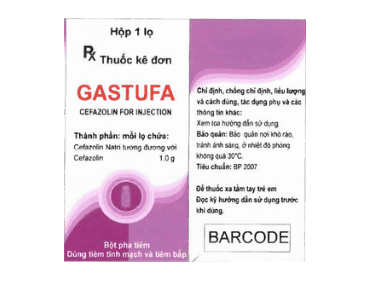This is an automatically translated article.
Ceftazidime is a cephalosporin antibiotic that inhibits the growth of bacteria. To ensure effective use and avoid side effects, patients need to take the drug according to the prescription or consult a doctor, a specialist pharmacist.1.General information about the drug Ceftazidime
Ceftazidime is classified as a cephalosporin antibiotic. The action of this drug is to stop the growth of bacteria. Ceftazidime drugs are prepared in the form of injections and powders for injection with the following concentrations:
Injections: Ceftazidime 500mg and 100 mg/mL, 170 mg/mL, 280 mg/mL; Powder for injection: Ceftazidime 1g, Ceftazidime 2g.
2. Uses of the drug Ceftazidime
Due to the ability to inhibit enzymes that synthesize bacterial cell walls, Ceftazidime has a bactericidal effect. Ceftazidime is stable to most bacterial beta-lactamases except Bacteroides enzymes. Ceftazidime is sensitive to many aminoglycoside-resistant gram-negative organisms and gram-positive organisms resistant to ampicillin and other cephalosporins.
Antibacterial spectrum:
The drug works well with: Gram-negative aerobic bacteria including Pseudomonas, E.coli, Proteus, Klebsiella, Shigella, Salmonella, Haemophilus influenza... and some strains of Pneumococcus, Moraxella catarrhalis and Beta-hemolytic Streptococcus and Streptococcus viridans. Besides, the drug is also sensitive to many anaerobic gram-positive strains, staphylococcus aureus is moderately sensitive to ceftazidime. Resistance: Resistance may develop during treatment due to loss of inhibitory effect on chromosomal-mediated beta-lactamases. Especially for Pseudomonas spp, Enterobacter and Klebsiella. Ceftazidime is not effective against methicillin-resistant Staphylococcus aureus, Enterococcus, Listeria monocytogenes, Bacteroides fragilis, Campylobacter spp., Clostridium difficile.
3. Indications and contraindications for the use of Ceftazidime
3.1. Indications In case of blood poisoning, bacteremia, meningitis, pneumonia, lung abscess, bronchiectasis, bronchiolitis, people with pancreatic cystic fibrosis with lung infection, otitis media, inflammation mastoid, sinusitis; Infections in other serious diseases such as nephritis - pyelonephritis, prostatitis , cystitis , urinary tract infections, erysipelas, abscesses, cellulitis; Secondary infections in burns (burns) or skin wounds; Mastitis, cholangitis, purulent cholecystitis, intraperitoneal abscess, peritonitis , diverticulitis, enterocolitis; Pelvic inflammatory disease, osteomyelitis, myelitis, septic arthritis, bursitis with infection. In addition, Ceftazidime is also indicated in the treatment of serious diseases such as:
Patients with impaired immune function due to severe blood infections; Severe infections such as infections in burns (burns); Infection associated with peritoneal dialysis or with continuous outpatient peritoneal dialysis (CAPD). 3.2.Contraindications Ceftazidime is not indicated for use in all people who are hypersensitive to ceftazidime or to any of its ingredients, including other cephalosporins. In particular, people with a history of anaphylaxis to penicillins should absolutely not use them.
4. Dosage and how to use Ceftazidime
Ceftazidime is administered by parenteral route such as intravenous injection, intravenous infusion or deep intramuscular injection. Depending on the severity of the disease, there will be a compatible dose, susceptibility, route of administration and depends on the age, weight and kidney function of the patient.
With sodium bicarbonate solution, Ceftazidime is less stable than other injection solutions. Therefore, it is not recommended to use sodium bicarbonate solution as a solution for injection.
Dosage for adults
Usually will be instructed to use in a dose of 0.5g - 2g (effective drug), frequency 2 or 3 times per day, intravenous or intramuscular. Doses of 500 mg or 1 g every 12 hours, as appropriate, intravenously or intramuscularly are indicated in the treatment of urinary tract infections and in non-serious infections; Ceftazidime 1g (potency) every 8 hours or 2g (potency) every 12 hours, intravenously or intramuscularly in most cases of infection; In immunocompromised patients, including those with neutropenia, use ceftazidime 2g (potent drug) every 8 or 12 hours or 3g (potent drug) every 12 hours, intravenously. or intramuscularly for serious infections; In patients with cystic fibrosis with normal renal function, if Pseudomonas lung infection is present, a high dose of 100 to 150 mg (effective drug)/kg/day, divided into 3 times/day, should be administered intravenously. intravenously or intramuscularly. There have been cases of using the drug at a dose of 9g (effective drug)/day in people with normal renal function. Dosage for children
Usually children over 2 months old will have a dose of 30-100mg (effective drug)/kg/day, divided into 2 or 3 times; In children with immunodeficiency or cystic fibrosis of the pancreas if infected, or in children with meningitis, the therapeutic dose can be up to 150mg (potential drug)/kg/day ( maximum of 6g (potency drug)/day). Dosage in infants and children younger than 2 months of age
Ceftazidime has been shown to be effective at doses ranging from 25 to 60 mg (potential drug)/kg/day in 2 divided doses. In neonates, the serum half-life of ceftazidime may be 3-4 times longer than in adults. Dosage for the elderly
The usual dose for the elderly is up to 3g (effective drug), especially for people over 80 years old.
Dosage for people with impaired kidney function
Patients with impaired kidney function, Ceftazidime is excreted more slowly than in normal people. Therefore, the patient's dose should be reduced accordingly, unless the patient has only mild renal impairment, the glomerular clearance is above 50ml/min. If impaired renal function is suspected, the starting dose may be 1g (effective drug). This group of patients should undergo an evaluation of the glomerular clearance to determine the appropriate maintenance dose.
5. Side effects of the drug Ceftazidime
During the use of the drug, patients may experience some of the following side effects:
Common side effects:
Local irritation; Thrombophlebitis; Allergies and gastrointestinal reactions; Itching, Macular rash, Less common side effects:
Headache, feeling dizzy, fever, Quincke's edema, anaphylactic reaction; Blood tests: eosinophilia, decreased platelets and white blood cells, decreased neutrophils, increased lymphocytes, positive Coombs reaction; Sensation, dysgeusia; especially in patients with renal failure, improper treatment may cause convulsions, encephalopathy, tremor, neuromuscular excitability; Digestive system disorders with symptoms of nausea or vomiting, abdominal pain, diarrhea. Rare side effects:
Blood tests: Agranulocytosis and hemolytic anemia; Pseudomembranous colitis; Erythema multiforme, Stevens-Johnson syndrome, toxic epidermal necrolysis; Status of increased transaminases, increased alkaline phosphatase; The glomerular filtration rate decreased, urea and plasma creatinine increased; Risk of superinfection with Enterococci and Candida.
6. Precautions before using Ceftazidime
Tell the treating doctor if there is a history of allergy to any drugs. Current or planned medications, including vitamins, dietary supplements, and herbs; a history of allergies, kidney disease, liver disease, colitis or stomach problems, diabetes, congestive heart failure, cancer, malnutrition, or recent surgery or emergency visit; Are pregnant or planning to become pregnant or are breastfeeding. This is a class B drug for pregnancy, so users need to weigh the benefits and risks before using the drug. Ceftazidime is a cephalosporin antibiotic that inhibits the growth of bacteria. To ensure effective use and avoid side effects, patients need to take the drug according to the prescription or consult a doctor, a specialist pharmacist.
Follow Vinmec International General Hospital website to get more health, nutrition and beauty information to protect the health of yourself and your loved ones in your family.
Please dial HOTLINE for more information or register for an appointment HERE. Download MyVinmec app to make appointments faster and to manage your bookings easily.













